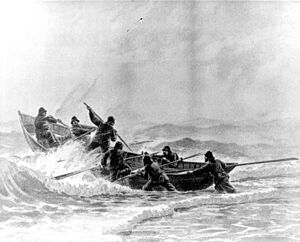United States Life-Saving Service facts for kids
The United States Life-Saving Service (USLSS) was a special part of the U.S. government. It was created to help save people from shipwrecks. This included sailors and ship's passengers. The service started on June 28, 1848. It was part of the United States Department of the Treasury. Later, in 1915, the USLSS joined with another group, the United States Revenue Cutter Service. Together, they formed the United States Coast Guard.
Why the Life-Saving Service Was Needed
Large parts of the Atlantic coast of the United States were not very populated long ago. This was true during the 1700s and 1800s. If a ship got stuck on the shore, even close to land, it was hard to get help. People might see a ship in trouble, but they often did not have the right tools or groups to rescue anyone.
Even in busy places like New York Harbor, ships could get stuck on sandbars during storms. A ship caught on a sandbar could break apart in just a few hours. Some people might swim to shore, but in winter, they could die from hypothermia (getting too cold). For example, in 1837, the ship Mexico got stuck on the New Jersey coast. All 112 passengers died before anyone knew about the wreck. This showed how much help was needed.
History of Saving Lives at Sea
Some groups tried to save lives early on. For example, the Massachusetts Humane Society started in 1786. People in Boston were worried about lives lost in shipwrecks. They opened the first lifeboat station in 1807. These stations were small sheds. They held small boats and gear for volunteers to use. The society knew that only small boats could be used safely in rescues. But these early stations were only near busy ports. Much of the coast had no protection.
On August 14, 1848, the U.S. Congress gave money for life-saving equipment. This was for volunteers along the coasts of New Jersey, New York, and Massachusetts. Some money went to the Massachusetts Humane Society. In 1850, more lifeboat stations were built. These were in Rhode Island, North Carolina, South Carolina, Florida, and Texas. In 1854, Congress gave $12,500 for metal surfboats for the Great Lakes.
However, saving shipwrecked crews was still not well organized. Lifeboat stations and equipment were not kept up. Some gear was stolen, and buildings were damaged by weather. On April 16, 1852, the ship Powhattan was lost. Over 200 people died just six miles from a lifeboat station. To make things worse, bodies that washed ashore were robbed. This made Congress think about creating a federal life-saving service. They started working on it in 1854, but progress stopped during the American Civil War.
The 1870 Atlantic hurricane season caused many deaths and a lot of damage. People across the country called for Congress to act. Sumner Increase Kimball was a lawyer who worked for the U.S. Department of the Treasury. In 1871, he was chosen to lead the Life-Saving Bureau. Under his leadership, the service grew. It expanded to the West Coast and the Great Lakes.
At that time, there were two main ways to save people from the water. If a ship was close to shore, they used a breeches buoy. This was a device on a rope that pulled someone to safety. The other way was to use a boat. Crews would row out through the waves to reach victims. These boats were about 34 feet long. They were partly covered to keep water out. Crews often rowed through waves taller than their boats. Around 1907, the boats started using gasoline-powered engines.
On January 28, 1915, the U.S. Coast Guard was formed. This happened when the Revenue Cutter Service and the Life-Saving Service joined together. During its 44 years, the Life-Saving Service helped 28,121 ships. They saved 178,741 people. Only 1,455 people died during rescues or attempts by the USLSS.
Images for kids




